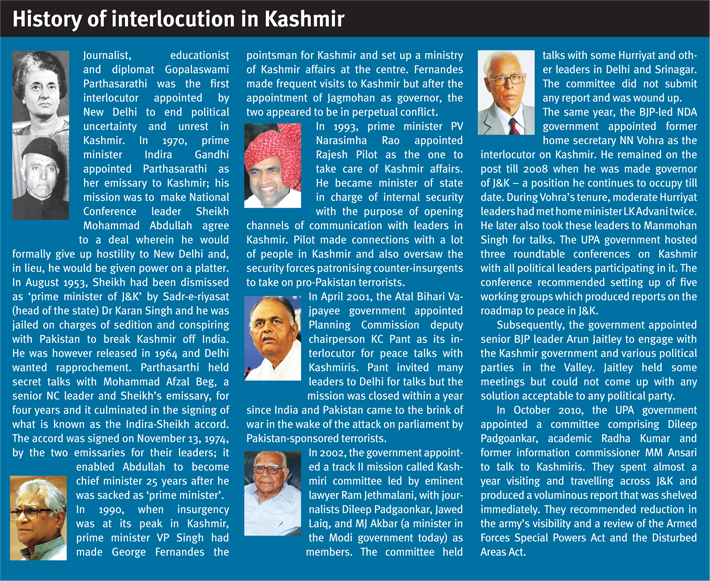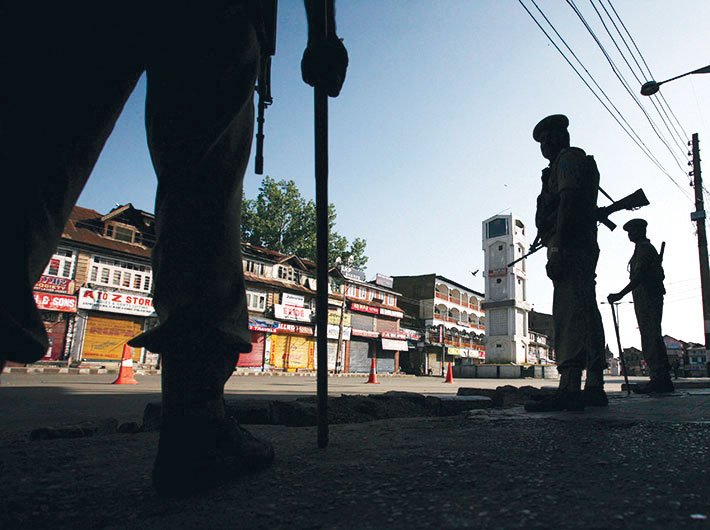Kashmir interlocutor Dineshwar Sharma sees hope despite hurdles, but treads warily
With the advantage of hindsight, one can say that the summer of 2016 was a turning point in Kashmir. Within days of the killing by the army and police of Burhan Wani, a handsome young man who was the first to appear on social media holding a gun and announcing he had joined the Hizbul Mujahideen, the Valley was convulsing in anger and frustration. Crowds of young men were swarming the streets and roads; they threw stones at security men and civilians. The stone-throwing looked like synchronised action across central and south Kashmir. In the rest of the Valley, smaller groups of men had turned into nocturnal vigilantes, keeping an eye on those who defied the ban and violated the hartal. Cars would be smashed and those travelling in these would be beaten up.
The state responded to the violence. Security forces used pellet guns against the stone-pelters, and in the process, 16 persons were killed and over 7,000 injured. Many of them lost eyesight in one or both eyes. Life in the Valley came to a standstill for nearly four months.
At this stage, home minister Rajnath Singh rushed to the Valley; he wanted to allay impression that New Delhi was callous to the agony of the Kashmiri people. In Kashmir, he empathised with the suffering of common people and promised to bring peace at the soonest. He also started visiting Kashmir more often. Sources privy to happenings at the top echelons in North Block tell us that each time Singh returned to Delhi, the impression grew stronger in his mind that nobody had even an iota of an idea of what precisely was making young Kashmiris so angry that they were lobbing stones and resorting to extreme violence.
After consultations with the prime minister’s office, Singh zeroed in on the soft-spoken Dineshwar Sharma, former director of the intelligence bureau (IB), to find answers to the nagging question of what exactly was happening. The Bihar-born Sharma was a Kerala cadre IPS officer of the 1979 batch who had retired 10 months ago. He had good experience in dealing with Islamic terrorism, insurgency, and peace efforts as well. Known for keeping a low profile, Sharma had also worked with Ajit Doval, the national security advisor (NSA), when Doval was heading the IB. Singh appointed Sharma as an interlocutor on Kashmir, which in simple terms meant that he would have to do the legwork and suggest how a semblance of peace can be brought to Kashmir for a possible eventual political intervention.
“Politicians have no idea of what can be done to change the situation in Kashmir, hence a former bureaucrat would be better to deal with this as he can, at least, do an impartial prognosis of the malaise”: this is how a senior authority dealing with Kashmir summed up Sharma’s selection.
The little-known fact about Sharma is that he is already an established peace negotiator: in Assam, he is talking to the United Liberation Front of Assam (ULFA), a militant group believed to be lying low after peace returned to the state. He’s also negotiating, in Manipur, with a plethora of Kuki tribes (almost 800), who have been demanding that a ‘Kukiland’ be carved out of present-day Manipur and Nagaland. His negotiations with the rebel groups in the northeast are aimed at preventing a flare-up and keeping the groups engaged in a dialogue lest China or other countries exploit their aspirations. Sharma’s brief in Assam is to prepare the ground for a situation when the process for issuing permanent residence certificates (PRCs) would be completed. A lot of people would be left out, and it could trigger unrest; so Sharma is also working to prevent that.
Sharma’s visits to Kashmir and Jammu, saw him dealing with familiar people – traders, tourism operators, representatives of the chamber of commerce and industry and other trade observations, fruit growers, transporters, border residents, unsettled refugees, displaced Kashmiri Hindus and more importantly, political leaders. He called on leaders of all parties, including chief minister Mehbooba Mufti, National Conference chief Omar Abdullah and MY Tarigami of CPM. However, his major interest was in meeting young Kashmiris, a generation that had grown amidst terrorism and public unrest, seeing security forces in every nook and corner of their villages and towns. He wanted to connect with them and find out what was brewing in their minds.
To add to Sharma’s difficulties, he found that the situation had changed since he was last in Kashmir in 1992-94 when he headed the IB there. At that time, insurgency and unrest were at their peak. He realised that, while in the nineties most of the young people who had joined militant groups were uneducated and had no aspirations, the youth who came to see him at the state guesthouse in Srinagar’s Civil Lines represented a generation of educated youth. Most of them are pessimistic about their future and hence the violent reaction. “A generation of educated youth being angry and aspirational is a very difficult situation to deal with,” he is believed to have remarked.

He also knows he has to deal with a generation influenced by extreme religious ideas emanating from places like Syria and Iraq, where ISIS had held territories, as against the ‘azadi’-driven youth of yesteryear. Besides, Kashmiri youth are also getting radicalised in countering the growing extremism among the Hindus across India during the current BJP regime. In the coming days, Sharma’s engagement with Kashmir will see the government unleashing many pending pro-people proposals. One of this had already been processed – amnesty for all first-time stone-pelters, including minors, who have been put in the jail under the draconian Public Safety Act of the state. This was Sharma’s first proposal to the government for ushering in peace in Kashmir. He is likely to give concrete proposals for generating jobs; offering incentives to the companies for taking up development works under corporate social responsibility (CSR) in the Valley.
According to sources privy to developments, Sharma is neither keen nor he is asked to speak to Hurriyat Conference leaders, who have publicly denounced his appointment and mission. Political leaders who met Sharma have advised him to “speak to everyone”, but speaking to everyone is impractical, and hence he is trying to focus on the angry youth to understand their state of mind. During his second visit to Kashmir he met youth in many locations in the volatile south Kashmir. His interactions were in camera sans the presence of local officials.
However, Sharma’s path to peace in Kashmir is strewn with roadblocks. He’s worried about the government’s inability to stem the tide of Islamic radicalisation of the youth. Reports from government suggest that Islamic madrasas offering good facilities have sprung up all over Kashmir during last eight years. All these years, a major fund flow from countries like Saudi Arabia and Ahl al-Hadith groups from all over the world for construction of mosques and Islamic schools has remained unchecked. Ahl al-Hadith, or the Salafis, want to change the ethos of Kashmiri’s Sufi and syncretic Islam to the one practised in Saudi Arabia and possibly espoused by many terror groups. “The happenings inside madrasas are beyond the control of authorities and hence to counter their influence on young minds, one needs to have better schools, with more facilities (than offered by neighbourhood madrasas),” he is believed to have suggested to the government. Given the chronic scarcity of funds for schools and education in Kashmir, Sharma has apparently suggested a special package for this. This has to be a long-term strategy for the governments in Delhi and Srinagar. The growing chasm between the twin regions of Kashmir and Jammu is also a worry for him. The differences were never so sharp and so brazenly manifest as these have been after the PDP-BJP government, now led by Mehbooba Mufti, took charge.
After his initial visits, Sharma is apparently optimistic about the chances of peace returning to the Valley. Since everyone has stakes in peace, if the government becomes an enabler in this, people would chip in too. “Peace is crucial to development; to creating jobs, for return of Kashmiri Pandits and ending violence,” he is believed to have told everyone in Kashmir.
Locals apparently seemed unconcerned about the killings of Pakistani terrorists by the army – around 200 killed in 10 months – but Sharma found them being upset about deaths of local youth, most of whom had joined terrorist groups in the wake of the 2016 unrest. This is already being addressed as forces are trying to rescue the local youth from the terrorist hideouts before these are blasted off. At times, they even use their families to make emotional appeal to make them surrender. Police has set up a toll-free number and a control room to help terrorists wanting to surrender.
Another positive indicator of Kashmiris’ urge for peace is the increased flow of intelligence about the presence of militants and their hideouts in villages to the security forces. This is causing heavy casualties to the terrorists. In Bandipore, north Kashmir, it was thanks to precise information that the army eliminated five top commanders of the Lashkar-e-Toiba in the second week of November. One of the killed terrorists was the nephew of the Pakistan-based terrorist Zakiur Rehman Lakhvi. “Pakistan has many terrorists to spare, and they would keep sending more, but if the people are with us and for peace, this would not matter much,” sources quoted Sharma as saying.
He apparently believes that Hurriyat too will come around to support peace for a very specific reason – the fear of radical Islamic forces, the likes of ISIS and Al Qaeda – taking control of Kashmir’s narrative and usurping their political leadership. Though the governments in Delhi and Srinagar are trying to underplay the presence of the ISIS in Kashmir, sources say the radical group has a cell in the Valley. It shows its presence by flying ISIS’s black flags in Srinagar downtown, wrapping shrouds of slain terrorists in the ISIS flag as against the general green Islamic flag and sporadic appearance of terrorist espousing the cause of the Islamic State on the social media.
“Unlike Al Qaeda or other Pakistan-based terrorist groups, the ISIS terrorists don’t have to march across the borders to Kashmir,” sources said. Zakir Musa, who was once a key member of the pro-Pakistan Hizbul Mujahideen and part of Burhan Wani’s ‘gang of 10’, is now the commander of the ISIS-Al Qaeda affiliate in Kashmir. Musa had created waves with his video message circulated through social media about his elevation as the chief of Gawzat-Ul Hind, a secret group owing allegiance to Al Qaeda.
In his strutting speech, which he was reading from a paper, Musa called the Hurriyat leaders self-seekers who had betrayed the cause of Islam by wanting Kashmir to get aligned with Pakistan. Musa made it clear that the fight in Kashmir is not political but religious. His group’s aim – the creation of a pure Islamic state in Kashmir – was very close to ISIS’s goal of a pure Islamic state in the Middle East. He even threatened to behead Hurriyat leaders and hang their severed heads in Srinagar’s Lal Chowk, for they had “betrayed” the cause of Kashmir and behaved as infields. He said Kashmiris had not shed blood for joining Pakistan but for making Kashmir an Islamic state.
The present-day Hurriyat leadership feels beleaguered in this situation – on one side the National Investigating Agency (NIA) is probing their links to terror funds and on the other, the threat from more hardcore Islamic groups for hijacking the movement looms large. This precise reason, Sharma believes, would force them to join the peace process.
However, Sharma’s efforts face a major roadblock – the 2019 Lok Sabha elections. As the BJP would be trying to stage a comeback on the national scene, the party would again focus on criticising minorities to consolidate its Hindu votes. At that time Sharma’s efforts in assuaging the feelings of Kashmiris and bringing them on the path of peace could go down the drain.
aasha@governancenow.com
(The article appears in the December 15, 2017 issue)

